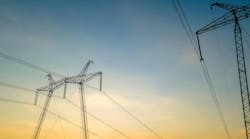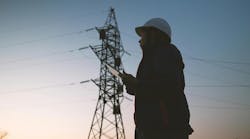One year ago, while repairing a 230-kV transmission line in the outskirts of Phoenix, Arizona, I flatlined. But I survived. Now, as a 41-year-old transmission maintenance lineman for Salt River Project (SRP), I am charged to educate other utility workers nationwide about the equipment that kick-started my heart back to life.
On Jan. 27, 2012, I died and came back to life. Had it not been for my five SRP transmission maintenance crew members who sprung into lifesaving action using an automated external defibrillator (AED), I would not have lived to see another day.
Looking back, I don't even remember what happened that day or the two days afterwards. As a lineman, I deal with hazards every day, and death is around me constantly. Our crew tries to negotiate danger safely with the tools we have on hand, and fortunately, we had access to an AED.
Saving My Life
I made electrical contact as I did routine maintenance work to reinforce and strengthen transmission structures on a 230-kV line southeast of Phoenix. I was injured by an induced voltage when I got in series with a static channel and a pole ground. The jolt affected the natural rhythm of my heart, causing me to have a cardiac arrhythmia, which means my heart was active but operating in a life-threatening, dysfunctional pattern.
Given the remote work site and the seriousness of my condition, my crew swiftly lowered the boom to the ground and removed me from the bucket. The operator then got on the radio and followed all of our radio procedures.
Just as they had been trained to do, my crew reached for the little red case found inside all SRP line crew trucks and most SRP facilities. The linemen hooked up the AED, delivered a shock and then performed CPR. They then gave me another shock, until I started breathing. They wouldn't give up on me.
Their actions and that device were the difference between life and death. They had my back that day, and they are the reason why I'm still walking around.
My team heroically used the AED to successfully treat me through defibrillation, a form of electrical therapy, which stopped the arrhythmia and allowed my heart to re-establish a normal rhythm. My coworkers then made me comfortable until firefighters and paramedics from the Apache Junction Fire District and Southwest Ambulance arrived.
Making the Investment
After paramedics stabilized me, I was airlifted by AirEvac Arizona to the Arizona Burn Center at the Maricopa Medical Center, where I was treated for burns to my hands.
When the incident happened, the phones began to ring. My crew members called my friends and family around the country, including my best friend. He works in transmission maintenance in the Midwest, and he heard about the accident even before my wife got a call. My friend immediately left his job site and flew straight to Arizona so he could be at my bedside when I woke up in the hospital.
After he made sure that I was going to be okay, he flew home to his family. When he returned to work, he asked his company if they could get an AED, but he was told that it wasn't cost-effective.
As SRP crews understand, however, providing AEDs to line crews isn't just a basic necessity, but it can have a profound impact. The costs can be eclipsed if just one life is saved. In this case, it was mine.
My electrical contact marked the first time an SRP employee was treated successfully by an SRP crew specially trained to use an AED.
While I missed three months of work, I was able to return back to my same crew when I recovered. I couldn't imagine what my family would be going through had we not had an AED.
We understand every day the value of the tool we are given, and we appreciate it. Not every utility company has AEDs or values their employees in the same way as SRP. I can't thank my company enough for making the investment to ensure we can go home every day.
Matt Collins ([email protected]) has been a lineman in transmission maintenance with SRP since 2008. He started as a project manager in 2000 with PAR Electrical Contractors in Las Vegas. Collins has worked in remote locations in Alaska, Oregon, Washington and Southern California. In 2005, he started his apprenticeship with IBEW Local 769 and worked for contractors such as Sturgeon Electric, TECC and Wilson Electrical Contractors. In 2007, he became a foreman with Henkels & McCoy and ran a four-man line crew, which handled pole change-outs and built a 69-kV line in Nevada that played a major role in providing water to Las Vegas residents.
Editor's note: To learn more about the CPR programs and training, visit www.heart.org.
The Ins and Outs of AEDs
Salt River Project equips all of its field crews' trucks with automated external defibrillators (AEDs) from Philips. Here are some lessons the utility has learned while deploying these lifesaving devices to its workforce.
-
Train your field workforce. SRP requires its field crews to complete AED, First Aid and CPR training annually, says Matt Peek, supervisor of transmission line maintenance for SRP. The utility partners with Heart Savers for CPR and First Aid training and PAR Education for CPR and AED training. The goal of the training sessions is to make the emergency-response skills automatic so crew members can act swiftly in the case of an emergency.
“Once everything was said and done, we had a conversation with the crew, and they didn't remember everything that happened or pressing the button,” said Peek. “It goes to show that if you give your employees the right training, it will pay off.”
-
Rapid response time is critical. The chance of survival decreases 7% per minute in the first three minutes without treatment and 10% per minute beyond the three minutes, according to the Red Cross. Irreversible brain and tissue damage may begin to occur after three to five minutes, but if the rescuer uses the AED within the first five minutes, then the victim has a 59% survival rate. Beyond this critical time frame, the victim could be susceptible to brain damage, organ failure and long-term injuries.
-
Don't depend on the ambulance to get to the work site in time. Unless the job site is located in a hospital's parking lot, there's no way that an ambulance can get to a job site that quickly, Peek says. He estimated that it often takes the fire department about 10 to 15 minutes to respond to an emergency, and by the time the emergency responders arrive, it may be too late. In the case of Collins' accident, it took the ambulance 30 minutes to travel the 5 miles from the hospital to the work site because of the rugged terrain, and they told the crew it was a good thing that they had access to an AED.
“The SRP crew on the scene is to be commended,” said Rob Bessee, division chief for the Apache Junction Fire District. “Their speedy, proficient response and proper deployment of the AED helped save Matt and made our job easier.”
-
AEDs are expensive but worth it. Before Matt Collins' incident, SRP had about 100 to 150 AEDs on hand. Collins works out of the East Valley Service Center, which had four AED units for the field crews to use during out-of-town assignments. The devices cost $1,800 to $2,000 each, but SRP decided it was worth the investment to equip its in-town and out-of-town substation, transmission and distribution crews with AEDs.
“We felt strongly that the investment in training and equipment was crucial to help keep our line crews safe,” said Rick Corven, SRP's director of electric system line maintenance. “AEDs were initially introduced at SRP as part of a pilot program in 2002. And currently, we equip all of our crew trucks with AEDs.”
-
If you equip field crews' trucks with AEDs, they can help others. One SRP crew came across a car accident, in which a doctor and a nurse were doing CPR on an injured person. The linemen pulled over and let them use their AED.
-
Make it known that there is an AED inside the work truck. SRP adheres stickers on the crew members' vehicles stating “First Aid Kit Inside” and “AED Kit Inside.”
-
Keep the AEDs in proper working condition. Just like any other type of equipment, AEDs must be maintained. Linemen and other field workers must check the battery life since cold weather can drain the batteries down. Also, they must check the condition of the pads, which have a certain shelf life. Also, the hot weather can cause the pads to dry out, and since it can get up to 120° in Arizona, the workers store the extra pads in the cab of the truck so they can be kept in air conditioning.
-
Document the condition of the AEDs. SRP's field crews are required to fill out a monthly inspection and log sheet to ensure the batteries and pads are in good working order.
Companies mentioned:
Heart Savers | www.heartsaversinc.com
PAR Educational Systems LLC | www.pareducation.com
Philips | www.philips.com
Salt River Project | www.srpnet.com

